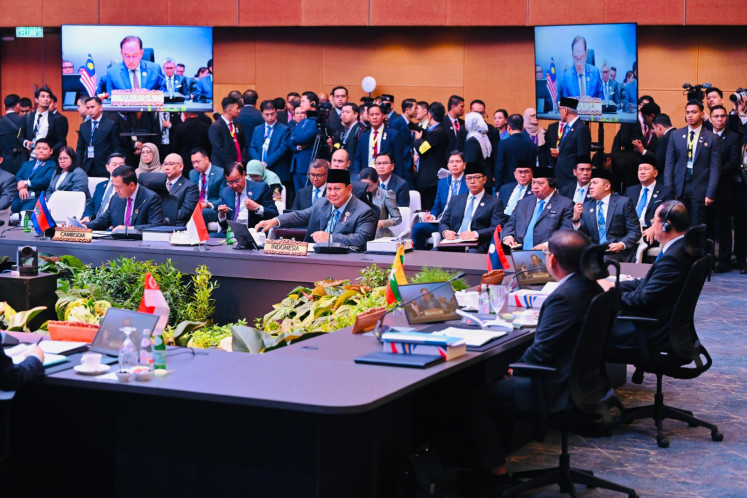Popular Reads
Top Results
Can't find what you're looking for?
View all search resultsPopular Reads
Top Results
Can't find what you're looking for?
View all search resultsChina’s dilemma: After the US reengagement in Southeast Asia
The East Asia Summit (EAS) 2011 in Bali revealed some compelling results, especially the involvement of the US in the forum, and the Southeast Asian countries’ growing positive outlook toward the US presence in the region
Change text size
Gift Premium Articles
to Anyone
T
he East Asia Summit (EAS) 2011 in Bali revealed some compelling results, especially the involvement of the US in the forum, and the Southeast Asian countries’ growing positive outlook toward the US presence in the region.
In fact, considering the rise of China’s power in the region and significant growth of China-ASEAN relations in post-Cold War era, the shifting of Southeast Asia’s preference may indicate a strong message: the specific aim of balancing against China, and in doing so, pushing China to react. However, will China respond by utilizing hard power to sustain its political leverage or will it reconsider its approach toward Southeast Asia?
There are two factors that support the occurrence of US-ASEAN reengagement, and complicate the current condition. First, there has been a shift in China’s measures toward Southeast Asia, which leads to the deepening of regional tension. Historically, the greater East Asia region (including Southeast Asia) has strong characteristics of suspicion and mistrust.
Actions taken by one country often generate distinct interpretations from other countries and can even lead to a security dilemma or conflict. This condition is worsened by several unsettled territorial disputes in the region, which may act as a triggering element.
Since late 2007, the growth of China’s assertiveness peaked with the Senkaku boat collision incident in 2010 between China and Japan in Northeast Asia, and the Binh Minh incident in 2011 between China and Vietnam in Southeast Asia, which both triggered several grievances.
Even beyond China’s historical claims to the disputed territories, the shift in China’s actions toward assertiveness showed its strong ambition for greater regional power.
Thus, China’s firm measures left other countries with no choice but to balance China’s power with political engagement with the US and call for broader approaches under the flagship of multilateral institutions.
Second, is the context of relations between the great powers in the region. The post-Cold War context of the Asia-Pacific region has been filled by the growing sentiment of the balance of power, especially between the US as the status-quo power and China as the rising power.
The direct implication for political relations is that both countries are seemingly involved in a struggle for the sphere of influence and political leverage in the region.
Despite the importance of economic considerations, which usually hinder the primacy of pushing for a firm political agenda, the US finally asserted its position in Southeast Asia as its pivotal strategy to maintain security. Indeed, this approach incites China’s suspicion.
Recalling the history of China-Southeast Asia relations, it can be seen that this complication is somehow rooted in the transformation of China’s foreign policy itself.
With the understanding that in the contemporary world, issues in politics, economics and culture are intertwined, Beijing realized the importance of utilizing image-building and credibility as the basis for its comprehensive power in the post-Cold War period. In fact, China has been striving to build its credibility as a responsible player at international level. Look at its involvement in ASEAN+3 and ARF.
Moreover, Beijing adopts the approach of “peaceful development” (heping fazhan), in which the government promotes a “friendly and good-neighborly” (mu lin you hao) relationship with adjacent countries. In this, it seeks to send a message that a rising China will also benefit its partnering neighbors.
Indeed, the development of China’s bilateral and regional measures has led several countries to be relatively more open to having closer relations with China.
This is also shown by the spirit of ASEAN in welcoming China’s support in creating the East Asia Summit and its cooperation in various areas.
However, with reemerging concerns over the South China Sea conflict, China’s benign image promotion started to be questioned.
Although China and ASEAN have agreed on the importance of peaceful means in resolution of the South China Sea dispute, Beijing has persistently changed its course of action.
The development of military measures, as happened with the Binh Minh incident, has ignited “threat perceptions” among Southeast Asian countries.
Consequently, China’s international credibility and soft power have rapidly weakened, especially with the increasing questioning of China’s integrity to comply with international law and bear international responsibility.
Hence, China cannot deny that the repercussion of misconduct or “perceived misconduct” will be detrimental for its power.
As Li Mingjiang (2009) noted, “excessive or inappropriate use of hard power can lead to the decline of a state’s soft power.”
China is now faced with the task of not only responding to the US resurgence, but also managing its assertive intentions and the need for regional stability and cooperation. Miscalculated actions may further deteriorate regional tensions, thus culminating in a weaker China.
In fact, the current Chinese government is still seen as passive, although the risk is that China could also be perceived as “weak and slow” by the US and the region.
However, this situation can lead to grievances in Chinese domestic public opinion, such that US actions are seen as containing China’s right to rise peacefully. Consequently, Beijing may be forced to act firmly.
Hence, Deng Xiaoping’s jargon of “hide our capability and bide our time” (tao guang yang hui) can have an important current relevance.
Despite US efforts to consolidate its strategic relationships with China’s neighbors, Beijing should deliberately react with regards to developing its soft power as a basis for its future investment.
In fact, the future triangular relationship between the US, ASEAN and China will become increasingly essential as a watershed in the broader milieu of greater East Asia.
Thus, the fundamental challenge for the region is the search for a dynamic balance between competing actors and the management of tension between them.
The writer is a fellow researcher at the Department of International Relations and the Institute of International Studies, Gadjah Mada University, Yogyakarta, and is currently a Bakrie graduate fellow at the S. Rajaratnam School of International Studies, NTU, Singapore










